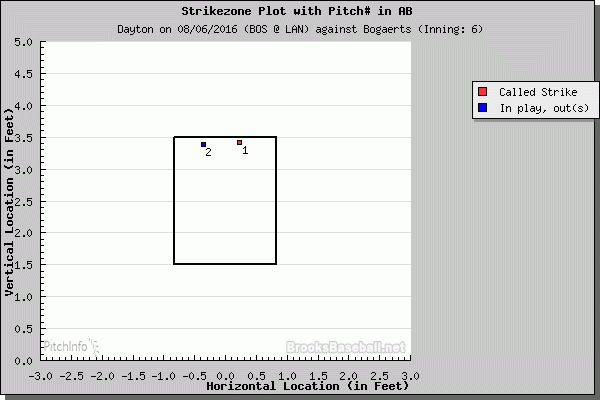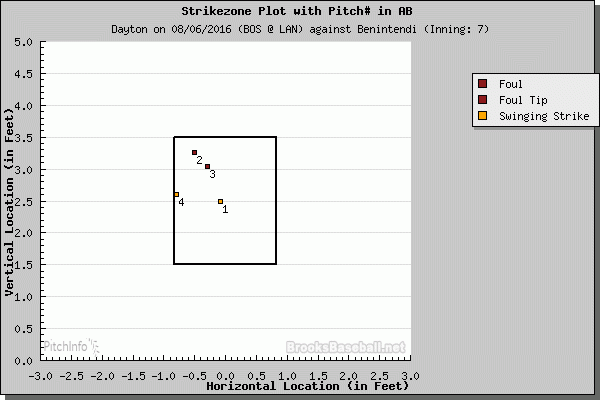Grant Dayton came out of nowhere, almost. Last summer, the Dodgers received him from the Marlins in exchange for first round draft pick/bust/Dustin’s favorite pitcher Chris Reed. Dayton’s minor league numbers showed promise, but only stuck out so much in an era with a sea of dominant relief aces. Guys who can strike out ten batters per nine in the minors are almost dime-a-dozen now, and the valuation compared to Reed made him seem like organizational depth. Dayton did not make Dustin’s top 100 prospects list before the season began.
This season Dayton has done his best to shed that perception. He made his first appearance of the year in Oklahoma City, but only faced two batters and allowed both to reach base. Following that game, Dayton was demoted to Tulsa. In his next 15-2/3 innings, he allowed a 0.33 FIP, striking out 28 of the 58 batters he faced while only walking three. The Dodgers responded to that dominance by pushing him back up to AAA, where he allowed a few more dingers but still struck out 63 of the 138 batters he faced while walking eight. Put Dayton’s minor league numbers together, and this season he has pitched 52 innings, struck out 91 batters, and walked 11. That’s a K%-BB% of 40%. Dayton is left-handed, but he’s not a LOOGY, with 18 of his 38 appearances stretching beyond an inning. Those kinds of numbers and that kind of usage combined are enough to get your attention.
The Dodgers agreed and called Dayton up for a cup of coffee against the Cardinals in late July. Dayton went two innings and struck out two of the seven batters he faced. He looked decent, though not quite as dominant as his minor league numbers would indicate. Dayton was sent back down, but Adam Liberatore‘s elbow problems combined with the struggles of J.P. Howell and Luis Avilan meant that the Dodgers had a need for a good left-handed reliever.
This brings us to Saturday. Grant Dayton had one of those outings that cause you to drop everything and lean towards the screen. Dayton was facing the Red Sox, who have the best offense in baseball and are no slouches against left-handed pitchers. The outing was so dominant, so effortless, that it is worth going into in significant detail, batter by batter.
Batter 1: Xander Bogaerts
Bogaerts is finally having the breakout season with the bat that many saw coming a few years ago. Dayton did something strange with Bogaerts: he started him with a curveball:
Of the 28 pitches Dayton threw on Saturday, only four were not fastballs. This particular pitch didn’t look very good in terms of depth, but it still managed to do its job as Bogaerts froze. On the next pitch, Dayton threw a 92mph high fastball, which Bogaerts hit lazily to right field for the first out.
Batter 2: David Ortiz
Ortiz needs no introduction. He’s playing his final season, but that doesn’t mean his production has faded. Dayton had the platoon advantage here, but Ortiz is still a formidable opponent.
Dayton started Ortiz out with two high fastballs, the first missing up, and the second missing outside and above the zone. Down 2-0, Dayton and A.J. Ellis decided to change tempo with Dayton’s only change of the outing:
This caught a little too much plate, but Ortiz was completely fooled. Ortiz then waved through a 90mph high fastball and Dayton finished him off with another fastball that was tipped into Ellis’ glove.
This GIF really shows off how Dayton hides the ball. It almost looks like Paco Rodriguez, but sideways instead of up. The ball stays behind him for a long time, particularly to a left-handed batter. This may partially explain Dayton’s dominance despite his unremarkable velocity.
Batter 3: Jackie Bradley Jr.
Speaking of breakouts, Bradley has been having a significant one this year, following up on a strong final month in 2015. Dayton had the platoon advantage here, though Bradley has been hitting lefties at about a league-average clip this season.
Dayton threw Bradley two fastballs, both not quite getting as high as he wanted (though Bradley gives a shorter zone than the above graphic would indicate). Bradley watched the first for a strike, then flew out to right, just short of the warning track. This was the hardest-hit ball of the outing, but luckily Bradley just got under it.
Batter 4: Sandy Leon
This was a rare lapse in control for Dayton. He started Leon with two straight curveballs, the first missing low and the second freezing Leon as it caught the outside corner high. Those were the final two offspeed pitches Dayton threw in the outing. The last four pitches of the plate appearance were fastballs, all missing well above their target. Leon fouled one back, but the rest were taken high for balls, allowing Leon to take first base.
Batter 5: Travis Shaw
Since winning the third base job over Pablo Sandoval this spring, Shaw has been rewarding the Red Sox with a solid season. Dayton threw four fastballs in this plate appearance. The first was his lone low pitch of the outing, called a ball despite being over the zone. Shaw fouled the second pitch into the Red Sox broadcast booth, narrowly missing Steve Lyons. The 1-1 pitch was fouled off of Ellis’ mitt, and the fourth, a signature high fastball, was foul tipped for strike three:
Pinpoint.
Batter 6: Andrew Benintendi
Benintendi isn’t a household name yet, but he’s considered one of the best hitting prospects in MLB. He was promoted last week after a rapid ascent through the Red Sox’ ranks (about a year ago today I saw him at a game in low A Lowell). Benintendi skipped AAA, but in the four ranks he played in he never posed a wRC+ below 139 and never struck out more than 11.4% of the time. Dayton threw Benintendi four fastballs and he whiffed on three of them, including this one on the outside edge for strike three:
Dayton caught Benintendi off-balance and late, which is probably going to be rare.
Batter 7: Hanley Ramirez
In some ways, Dayton saved his best for last, so much that it’s worth just showing all of the pitches.
The misses were good misses. The rest fooled somebody who was once one of the best hitters in baseball. Five fastballs, two more whiffs, and Dayton’s second inning concluded with three consecutive strikeouts. Hanley’s not the same as the hitter we saw with the Dodgers, and he was dealing with a sore wrist and pinch-hitting, but Dayton deserves a lot of credit for dispatching him so easily.
—–
Grant Dayton threw 28 pitches on Saturday. 24 were fastballs, three were curves, and one was a change. The fastball was the star of the show, as the above GIFs show. Long-term it would be good if he mixed his pitches more, but the results of that outing speak for themselves. Dayton’s fastball spin rate isn’t superlative, but against the Red Sox he averaged +11.6 inches of vertical break. Among relievers with at least 100 fastballs thrown, that average would be within the top ten. Dayton’s pitches weren’t moving nearly as much in his outing against the Cardinals, so it’s hard to know which sample to trust going forward. Dayton’s fastball induced eight whiffs among fifteen swings, an elite rate.
Dayton’s pitching style is reminiscent of what Yimi Garcia looked like at the beginning of last season. The results eventually caught up to Garcia, but until his injury he was still a very good reliever. Garcia threw almost exclusively high fastballs, got plenty of whiffs, and topped out between 93 and 94, just like Dayton does now.
It’s hard to know how much of this will carry forward, but within seven batters Dayton put himself on the map. The Dodgers need a good left-handed reliever, and Dayton showed that his minor league numbers may not be something to ignore. What more can you do in one appearance?
Zone profiles via Brooks Baseball.
 Dodgers Digest Los Angeles Dodgers Baseball Blog
Dodgers Digest Los Angeles Dodgers Baseball Blog






